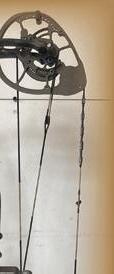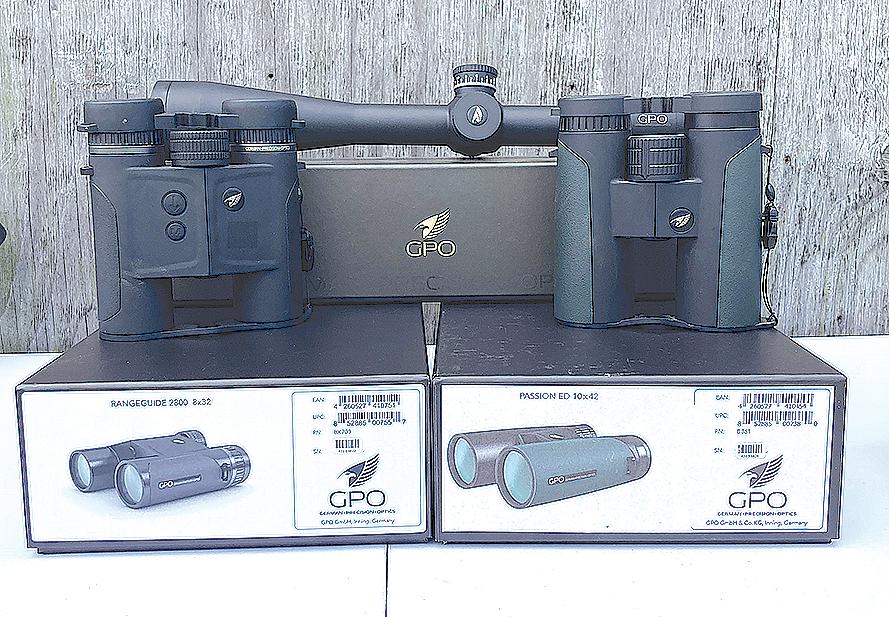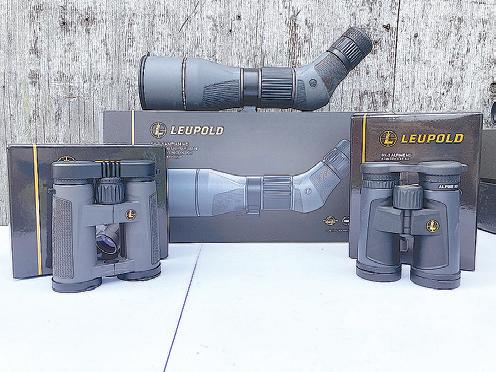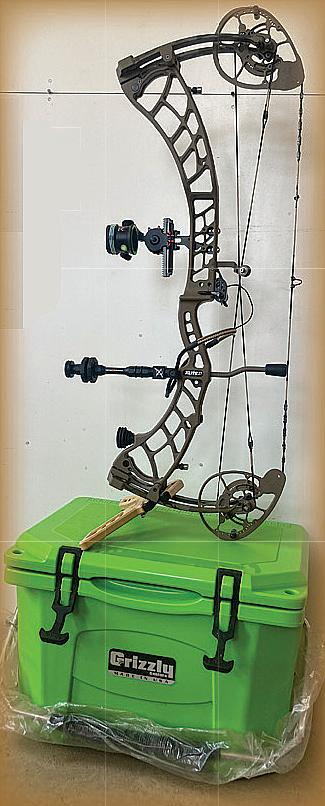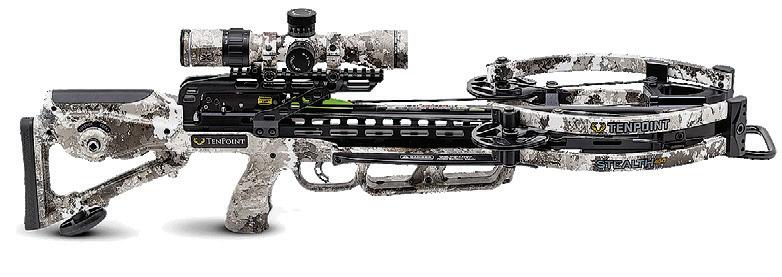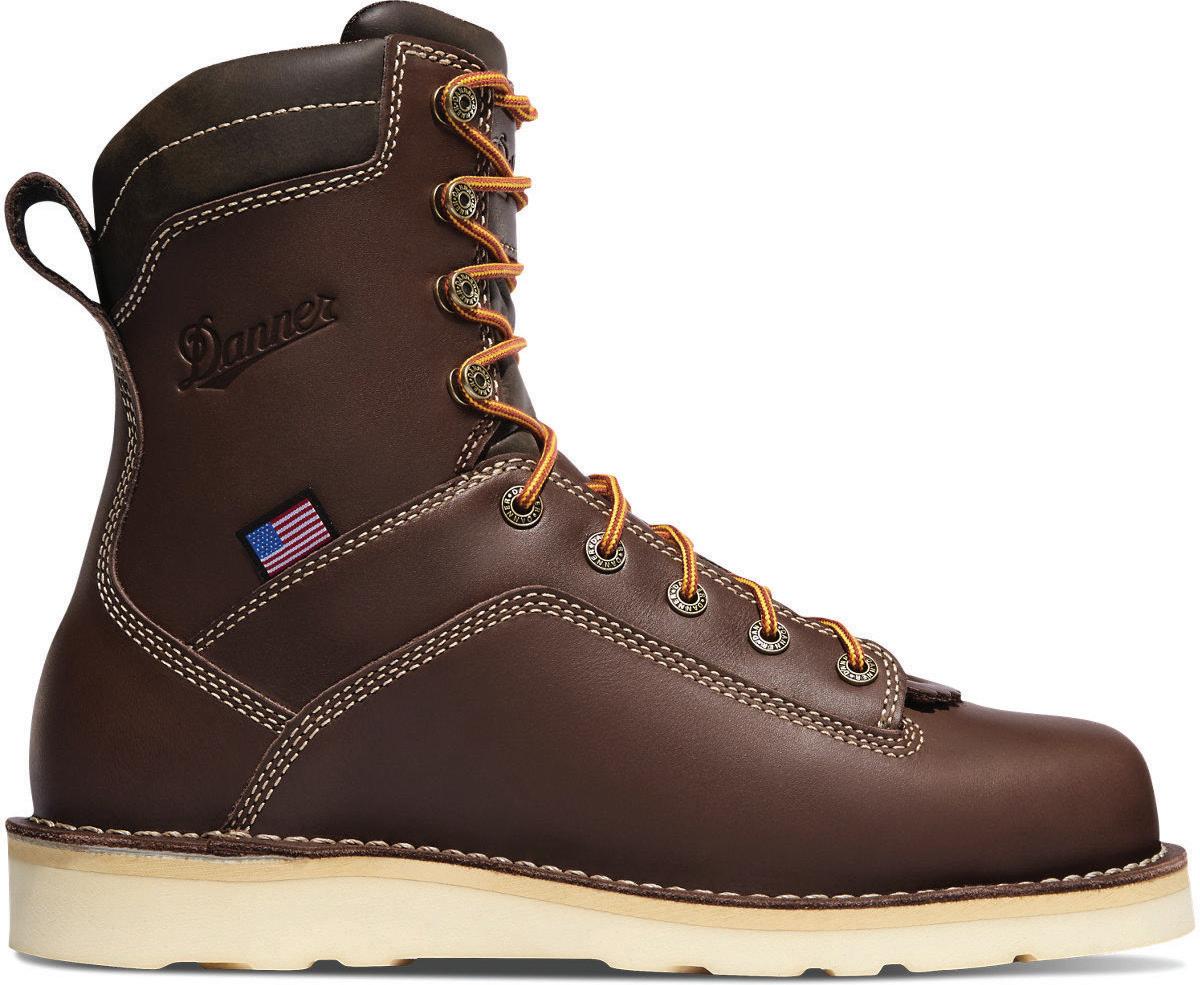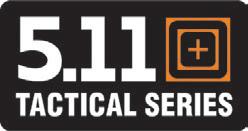






























































































































































































































































































































































































































































































































The morning sun peeked above the skyline and bathed the autumn landscape in a golden glow. The yellow, red and orange leaves seemed to sparkle in its light, silhouetted against a bright blue sky. Indescribably beautiful. What a day to just be alive!
My dad, Dick Robertson, and I slid the canoe into the Allegheny River and loaded up the fishing gear and shotguns. We were ready for literally anything with fur, fins or feathers.
The clear autumn waters swirled gently under the highway bridge, sprinkled with fallen leaves in all their assorted colors. The majority were bright yellow, courtesy of the large maples so common along the river’s banks. With our gear aboard we pushed off from the shore and headed downstream, our paddles leaving little swirling whirlpools in the cold waters as we moved to the center of the river.
I set my paddle down, grabbed the shotgun and loaded it with some steel No. 4s. You never know what may be just around the next corner — ducks, geese or a squirrel high in a tree. I was just about the snap a lure on the fishing rod when I happened to glance downstream. To my amazement, I had to look

Fall provides many opportunities to hunt and fish at the same time. My late father and I took a float trip years ago and had a fantastic day catching bass and walleyes, bagging a few squirrels and taking several ducks. CONTINUED ON PAGE 5

twice to make sure my eyes weren’t playing tricks on me, a large, gaudy cock pheasant sat on a log sticking out into the river!
Turning, I motioned to Dad, whose mouth flew open in surprise. He silently turned the canoe, slanting it across the current toward the cockbird. When we were within range I pulled the trigger and, presto, the day was off to a great start.
Dad kept the canoe tight against the bank and began paddling us rapidly, silently downstream. As we rounded a steep bend four wood ducks exploded from the water in front of us. I dropped two of them before the others sped out of range. Wow, not half a mile downstream and we’d already bagged two ducks and an unexpected pheasant. What a start to an already gorgeous day!
Several other flocks of ducks flushed out of range on long straight stretches of water, but it wasn’t long until we jumped a big black mallard as we curved tightly around another bend. It was a long shot but the duck dropped.
A mile downstream we passed a stand of hickory. In the top of the largest we spotted two squirrels. Again, keeping very close to the bank kept us inconspicuous. Dad had his chance now and he fired bagging both of the fat grey squirrels. We beached the canoe and still-hunted the area for a spell, adding four more squirrels to the pot.
By now our stomachs were growling and we built a fire for lunch. I don’t know what it is about a wood fire, but its humble flames can turn the plainest fare into something fit for a king. We cut some Y sticks and stuck fat pieces of ring bologna on them. Soon they were ready, the skin crackling open, their rich juice running and dripping into the fire. The flames had worked their magic, common bologna suddenly turned into gourmet fare.
Next, we balanced our sandwiches on the Y sticks and toasted them. My dad has a well-deserved reputation for dropping his food into the flames
and burning them a bit. He didn’t disappoint me. Today, we had tuna fish made with Miracle Whip, further flavored with diced celery and onions. When the bread was brown and toasty I bit into the sandwich. The bread was hot and the thick tuna fish still cold in the center. Perfect! Just the way I love it.
A cool drink, then we lay back in the sweet-smelling fallen leaves and watched the small clouds chase each other across the sky. It doesn’t get much better.
Back into the canoe, it was time for a little fishing. Occasional drifting leaves snagging our lines. Anchoring at the head of a deep run Dad cast a No. 3 chartreuse Mepps, letting it swing cross-current. A hard strike resulted in a 24-inch walleye. Dad was thrilled.
Hurriedly casting myself I caught an 18-inch walleye. Two more 16inch walleyes followed. Oh, why hadn’t I brought some nightcrawlers? In the next quarter mile, we also caught four smallmouth bass. We only kept


the walleyes; there was enough game to clean as it was.

We jumped some more ducks and managed to bag three more. By the time we made it to the next bridge, hauled the canoe out, washed the canoe and put it on the car we were more than ready to call it quits.

On the way home we relived our wonderful day's hunting and fishing — it had been a remarkably productive one. Great weather, fall colors, a pheasant, squirrels, assorted ducks, walleyes, bass, a wonderful lunch and the chance for a father and son to share some precious time together.
“By the way," Dad remarked with a sideways glance. “I’m the one who seemed to spend most of the day paddling. How'd that come about?”
I hesitated before replying; dad knew he wasn’t a great wing shot.
“I think we were both exercising our talents to the best advantage,” I answered with as innocent look as I could manage.
“Maybe,” he answered with a grin. “Maybe.”



 By WADE ROBERTSON
By WADE ROBERTSON
Archery hunting can be an incredibly exciting sport. It requires planning, scouting, placing and hanging a stand or stands, and then dealing as best as possible with the everyday changeable, often challenging conditions such as wind, rain and other hunters.
Once the preparation’s accomplished and you’re safely in your stand, archery hunting becomes far more enjoyable. Finally, you can sit back and watch and listen to the wonderful fall world surrounding you, enjoying animals both large and small as they go about their everyday business.
In my experience, archery season can be broken down into three stages.
The first is, of course, the opening week or so. The deer are not alarmed and you should know where and what they’re feeding on. Say the deer are hitting apples trees or consistently visiting a field. You should know what time they show up and what direction or trail they are approaching from. Hang your stand as early as possible, clear your shooting lanes and know the ranges to various objects.
Before hanging your stand have a plan on how to approach the stand
without the deer scenting you on your approach.
I cannot stress this enough; deer can smell you from a long, long distance. A doe or fawn may still cautiously approach a feeding area after winding you, but a big, smart buck won’t.
Once you’ve located deer your best stand that day will be the one you can sneak into, according to the wind direction, without letting the deer winding you. If it’s impossible to do this and you insist on hunting from that location get in position as early as possible and do everything possible to limit your odor.
The second period begins when the leaves begin to fall and the woods
become more open. Now deer become more cautious, not entering their feeding areas until after dark. If this happens, move your stand further back into the cover since the deer are hanging some distance back at what I call a staging area before coming out to feed.
Staging areas are generally within 100 yards of the feeding area and downwind from them; the deer use their very reliable noses to make sure it’s safe before venturing into the open. I can’t tell you how many nights I wasted sitting over an apple tree only to spook the deer when I climbed down after dark. Sound familiar?
When I finally wised
up and moved back the well defined trail about 100 yards to a small clearing the deer were moving through I had success.
The third stage of archery season and the most anticipated is the rut!
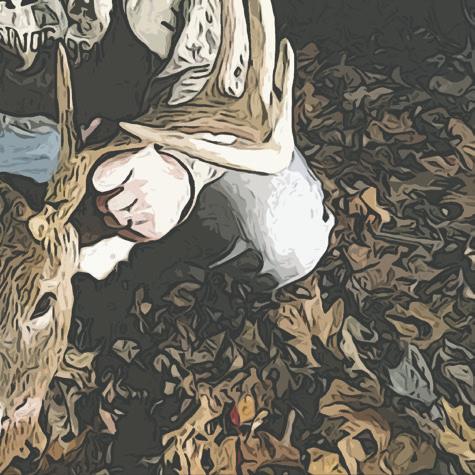
Now the bigger, heavyhorned bucks climb out of the thickest cover and begin roaming the woods looking for the ladies. Where they come from and where they end up are impossible to know, but when the rut is in full swing you have just as good a chance of seeing a monster buck at noon as you do in the last hour of daylight.
Bucks have only one thing on their minds and are constantly moving, searching for a doe in heat. It is easy to deduce that you should be in the areas does are frequenting if you’re going to stand a good chance of getting a shot at one of these huge, mossy horned, wall hangers.
Again, it largely comes down to how hard you have scouted your area over the years. If you know the core area of one of these extra large deer, where the does usually feed and bed nearby you have a reasonable chance of at least seeing your buck sometime during the rut. Putting out some scent, using a doe bleat call and grunt tube can occasionally
CONTINUED FROM PAGE 6
pull in one of these big boys as well.
The week before the rut and the first week of the rut are usually the best times. Once a buck locks up with a doe he stops moving and tends her. You want bucks to still be actively looking and covering territory, just before the does come in heat. Once a buck is locked down on a doe a still hunter can use his talents and walk up on him. If you are not a stand sort of guy, moving upwind slowly through thicker cover can sometimes pay off as the buck is nowhere near as spooky as he normally would be and may be moving around quite a bit.
You just have to be fortunate enough to find and then see him in time. Don’t still hunt near your stand for you risk chasing the deer out of the area and leave your scent behind.
Of course, you want to practice, practice, practice with your bow before the season. Make your practice sessions real and challenging. Place obstacles about a foot apart, half way to your target to simulate tree trunks. You might also want to place some horizontal obstacles in the same position so you can determine how high an arc your arrow has midrange.
Always shoot at targets even smaller than the kill area on a deer, not only to give you confidence in your own ability but — who knows? — you might have to take a shot through a very small open-

ing. Be prepared for lessthan-ideal circumstances when waiting for a shot; things can get dicey very easily, especially when a big buck is involved.
Stand placement is critical. You must avoid being too close to steep side hills, your scent can blow directly to the deer and you’re also easily seen by deer on that hill and at your same level.
Avoid the bottom and sides of bowl-shaped depressions, changing wind velocities suck, pull and push your scent in every direction in such areas. Get as high as you can, 20 feet is a great height. Try and avoid being on a straight tree without other trees and limbs close by to break up your silhouette. Deer do look up every now and then, especially if they hear a noise, see movement or catch a downdraft whiff of your scent.
I hope I have given you a few things to think about. Hunting is an art, where hard work, careful observation and, occasionally, even intuition can play a critical part in your success. You might even want to keep a notebook, keeping track of the locations and times you are seeing deer, what the weather conditions are, what they are feeding on, the phase of the moon and any other variable you can think of.
Sometimes the proper application of this information can make all the difference between success and failure.




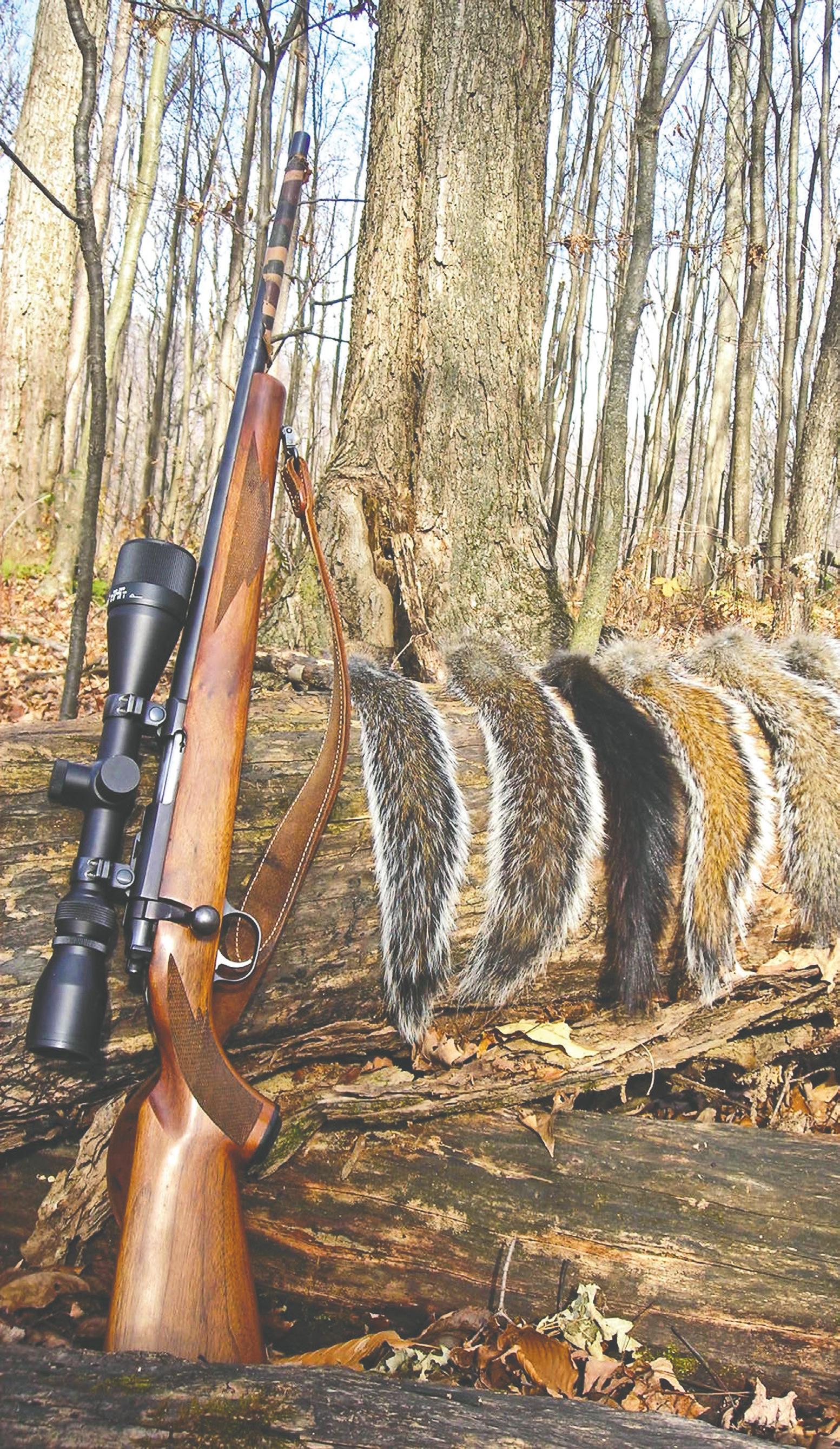 By WADE ROBERTSON
By WADE ROBERTSON
Hunting squirrels with a rifle is the ultimate test of a hunter's stalking and shooting skills. Squirrels are seldom found sitting still like many photos show them, posed picturesquely on a stump, log or limb in the wide open.
In the woods, they are commonly foraging on the ground, hopping, pausing for a second or two, changing directions, disappearing into dips in the ground or behind brush.
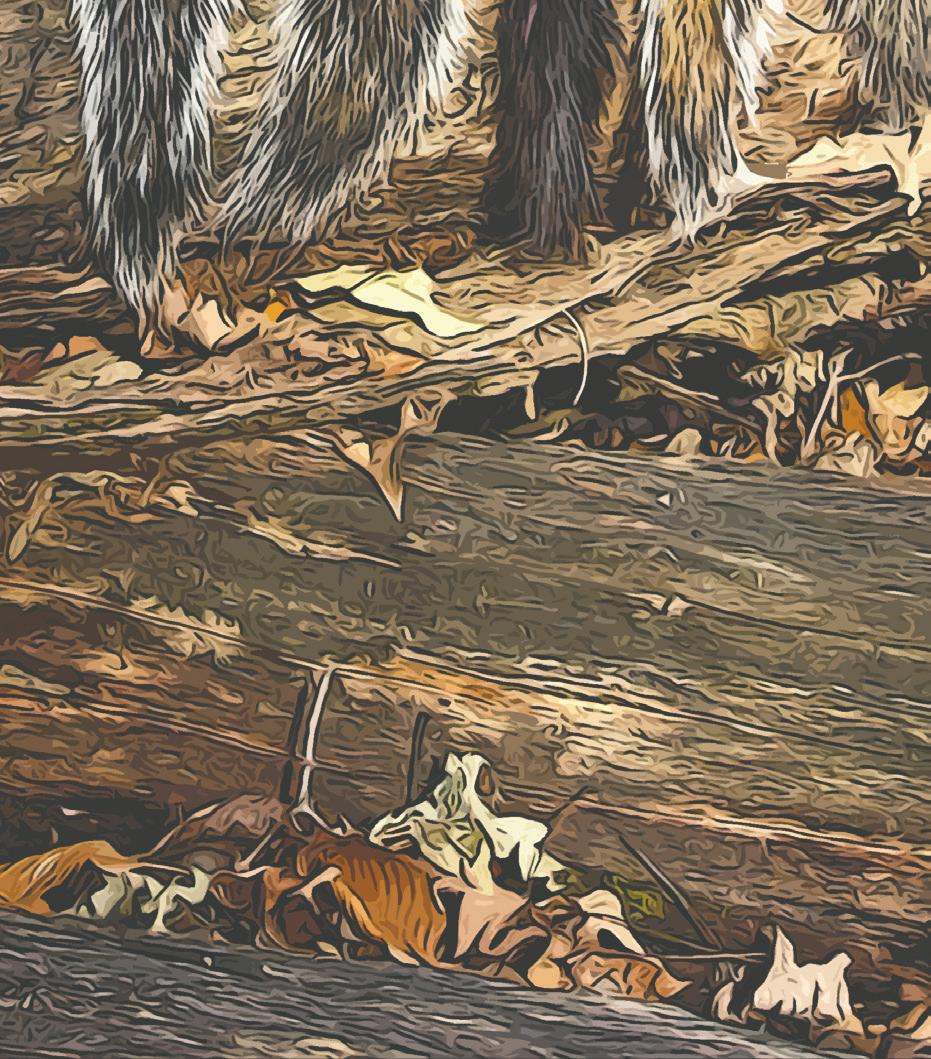
You, in the meanwhile, are trying to draw a bead on the squirrel, hold steady and squeeze off a quick, accurate shot. Believe me, the squirrel manages to avoid being shot at far too often and you are left red-faced and frustrated!
Squirrels can drive you crazy when high in the tree tops as well, grabbing a nut and dashing back to the main tree trunk. They hunker down where you can’t get a clear shot, finish the nut, dash back out on a limb, grab another nut and repeat the process until they spot you or run off to an unknown destination. This little game of hide and seek can go on for what seems like forever. I’ve developed many a stiff, aching neck trying to draw a bead on a wary squirrel high in the top of a hickory or oak. As you can see, when the opportunity for a shot presents itself, you better not miss.
Of course, it is not unusual for the hunter to become impatient and take a shot he
CONTINUED ON PAGE 9 ➵
A morning’s limit of squirrels is not as easy as some might think. This nice group from a .22 magnum is what you like to have for successful squirrel shooting.
shouldn’t — twigs in the way, leaves partially obscuring the squirrel, a bad angle. You miss almost 100% of the time in these situations, of course, and then hate yourself for not being more patient and waiting for a better shot. Some days it seems you can’t win.
I started out hunting squirrels with a good old .22 long rifle. I prefer target-grade ammo in standard velocity. Hollow points can be messy and high speed solids don’t shoot as accurately and for some strange reason don’t seem to kill as well in my experience. If your shooting is occasionally a little off, hollow points eliminate wounded squirrels, usually anchoring them with marginal shots — well, almost any shot. However, if you’re patient and shoot straight, the standard-velocity ammo will anchor a well-hit squirrel with no problem — and less waste.
Optics wise, a quality 3x9 or 4x12 scope with an adjustable objective is a must for the serious
squirrel hunter. Set your parallax at 35 to 40 yards early in the season, 50 yards when the leaves are off. Don’t go above 40mm , the larger objective lens are designed for long range shooting, distances of 100 yards and above. Many squirrel shots are very close, 15 to 20 yards.
I prefer the .22LR cartridge early in the season. The remaining leaves provide cover enough to stalk closer for easier shots and the long rifle’s noise is minimal sometimes allowing a second or even a third shot. It is even possible to occasionally shoot two to three squirrels out of the same tree with LR ammunition. The spat of the rifle doesn’t spook them unnecessarily and the thud of the bullet hitting the tree often draws their attention, not the rifle. Squirrels many times jump at the shot if you miss, run and then look back, allowing a second attempt. Not always, but enough to be a factor in a morning's hunt.
A second highly effective round is the .22





magnum — accurate, powerful, flatter shooting and capable of longer shots. I like the fact the solid bullets hit very hard, but seldom ruin any meat. Since I always try to shoot the squirrel in the head, any angled shots occasionally pass through the neck, striking the opposite top shoulder blade as they exit. Hollow points completely ruin that shoulder; solids seldom do, allowing you to save the leg. If the squirrels are spooky that day take a chest shot, the .22 mag usually dropping them in their tracks.
My third favorite squirrel round is the .17 caliber. This ammo costs about the same as .22 magnum ammo and provides an even flatter trajectory. Zeroed in just a hair high at 50 yards, they allow you to hold dead on past 80 yards. Believe me, a squirrel at 80 yards looks mighty small and if you can pull that shot off you have reason to brag.
Use the 20-grain hollow points and be very careful on your shot placement or use solids. Solids are


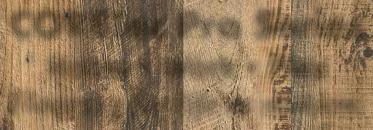


the perfect squirrel round, their high velocity impact dropping squirrels like Thor’s hammer with a solid hit.
No matter which rifle caliber you use that first limit of squirrels is a special accomplishment, a feat producing an intense feeling of satisfaction.
Having spent the time and effort necessary to become a proficient squirrel hunter you’ve also developed all the basic skills necessary to hunt any big game animal in the world. You couldn’t have reached that triumphal moment without earning it, overcoming all the failures and frustration squirrels can throw at you.
Maybe you yourself wish to become more proficient at stalking and shooting. If so, get yourself an accurate rifle with a quality scope. Squirrel hunting can develop you into an expert hunter faster and with less expense than any other method. Good luck and good hunting!

The 2022 hunting season harvest of black bears in Cattaraugus and Allegany counties was consistent with the previous year, according to state wildlife officials’ annual report.


A total of 46 bears were taken in Cattaraugus County in the 2022 season, virtually the same as 2021’s total of 45. The top town in the county for bears taken was South Valley with 10, followed by Allegany with 6 and Coldspring with 5.
In Allegany County, hunters took 38 bears in 2022, down slightly from the 41 taken in 2021. In the town of Wirt, 10 bears were taken, while the next closest towns throughout the county were three or two bears each.
The DEC reported that, overall, New York bear hunters took an estimated 1,318 bears during the 2022 season. As in past years, the Catskill region recorded the greatest bear harvest densities.
Hunters harvested an estimated 458 bears in the Northern Zone and an estimated 860 bears in the Southern Zone, an increase of about 14% in the north compared to the previous year and a decrease of approximately 9% in the south.
DEC reported the total bear harvest was approximately 10% fewer than the five-year average. As in past years, the Catskill
region produced the greatest bear densities. In Wildlife Management Units (WMUs) 3C, 3H, 3K, 3M, and 4R, hunters took more than 10 bears per 100 square miles, with hunters taking more than 15 bears per 100 miles in WMU 4R.
In the Southern Zone, approximately 15 hunters took bears with a bow, eight used a muzzleloader and 434 hunters were successful during the traditional firearms season for deer and bear, which runs the Saturday before Thanksgiving Day for three weeks. One youth hunter was reported to have taken a bear.
Some more notable bear hunting numbers reported by the DEC:
• 13 AND 93: The ages of the youngest and oldest hunters who successfully harvested a bear in 2022.
• 15.5: The number of bears harvested per 100 square miles in WMU 4R (western Greene County and portions of Schoharie, Delaware, and Ulster counties), which had the greatest bear harvest density of any WMU.
• 11.8: The number of bears harvested per 10 square miles in the town of Port Jervis, Orange County, which had the greatest bear harvest density of any town.
• 520 POUNDS: The heaviest dressedweight bear reported to the DEC in 2022, taken in the town of Windsor, Broome County, WMU 7S. Scaled weights of dressed bears were submitted for 26% of bears taken in 2022.
• 612: The number of hunter-harvested bears in 2022 from which DEC collected teeth to determine the bear’s age.
Black bear harvest data are gathered from two main sources, harvest
reports required of all successful bear hunters and the physical examination of bears by DEC staff and cooperating taxidermists. Harvest estimates are made by cross-referencing these two data sources and determining the rate at which hunters report bear harvests in each zone.
In 2022, 80% of successful bear hunters in the Northern Zone and 89% of successful bear hunters in the Southern Zone reported their harvest.
The USDA Forest Service opened 135 forest roads on the Allegheny National Forest for hunter access on September 24, 2023, unless otherwise noted.
Twelve additional forest roads will open later in the season. Hunter roads lists, with specific opening and closing dates, for the Bradford and Marienville Ranger Districts are available on the forest website.


Traditionally many of the normally gated roads are opened each fall to allow preseason scouting and legal hunting during select Pennsylvania hunt seasons. An Interactive Hunting Map is available on the forest website under Maps and Publications.
Note that only the main roads and listed spur roads are open. Side roads are closed to vehicle traffic. Roads may be closed at any time due to weather, unsafe conditions or to protect resources. Disabled hunter roads are only open for use by hunters possessing a Disabled Persons Permit issued by the Pennsylvania Game Commission. Drive these narrow, high-clearance roads with caution. Some open roads may have maintenance or timber sale activity in progress. While open, proceed with extra caution and expect poor road conditions and trucks or heavy equipment on these roads. Unless otherwise post-
BEAR HUNTING
The north central region of Pennsylvania, which includes McKean, Potter, Elk and Cameron counties, produced the most black bears in the 2022 hunting seasons.
A total of 1,028 bears were taken in the region; they were among 3,170 taken overall, the Pennsylvania Game Commission reported. That was down from the 3,621 in 2021, but still enough to rank the
ed, non-motorized use, including hiking, biking and horseback riding, is always allowed on gated roads. Off-highway vehicle use is not allowed off the designated ATV/OHM trail system at any time.
The status of roads can change at any time. Contact the Bradford Ranger District Office at (814) 363-6000 or the Marienville Ranger District Office at (814) 927-6628 with ques tions.
The Allegheny Nation al Forest Motor Vehicle Use Map contains the current road policy. Maps are available on the forest website on the Maps and Publications page.
CONTINUED FROM PAGE 10
harvest as the 14th largest all-time.
Pennsylvania’s all-time best bear season came in 2019, when hunters took 4,653.
Among counties, Tioga County produced the most, giving up 187 bears last season. Lycoming County ranked second with 152, followed by Bradford and Luzerne counties with 126 each, Centre County with 122, Potter County with 119, Clearfield and Monroe counties with 114 each and Clinton County with 113.
McKean County, with 52 bears in 2022, was down by more than half from the 2021 harvest, which was 107. Elk County was at 85 in 2022, up from 80 in 2021, and Cameron County was at 52, down from 68 the year before.
The PGC reported that hunters harvested some tremendous bears in 202, including three of more than 700 pounds and 11 more that topped 600 pounds.
The largest taken in 2022 was the 755-pounder
harvested by Cory Bennett of Toms River, N.J. He got it with a muzzleloader on Oct. 15 in Monroe County. The heaviest bear ever taken in Pennsylvania was an 875-pounder in 2010 in Pike County. Since 1992, seven black bears weighing at least 800 pounds have been lawfully harvested in the state.
A 693-pounder was taken with a rifle on Oct. 20 in Abbott Township, Potter County, by Elijah Smucker of Paradise, Lancaster County.


































Bowhunting season for deer and bear in the Southern Zone of New York is well underway, as is the general small game season for squirrels, rabbits and ruffed grouse.
Hunters may use crossbows to hunt deer and bear from Nov. 4-17.
Here’s a rundown of the hunting seasons for 2023-24:
As mentioned, squirrel, rabbit and grouse season is in and runs through Feb. 29 in the Southern Tier. DEC encourages grouse hunters to take part in the grouse hunting log program and submit feathers from harvested birds to assess recruitment (number of young produced per adult female grouse) for different parts of the state. Interested hunters should visit the DEC website.
The pheasant hunting season begins Oct. 21 in central and western portions of the state.
Regarding the New York Department of Conservation’s pheasant stocking program, during the spring, the Reynold’s Game Farm suffered a Highly Pathogenic Avian Influenza outbreak in the breeder flock. After enacting precautionary
measures to ensure the facility was properly decontaminated, DEC secured a contract to acquire 30,000 pheasants from a commercial hatchery to supplement fall upland bird hunting opportunities around the state.
Prior to the pheasant season, DEC will release adult pheasants on lands open to public hunting.
Since 2007, DEC has offered a special youth-only season to provide junior hunters the opportunity to hunt pheasants during the weekend prior to the regular pheasant hunting season.
In Western New York, the youth pheasant hunt weekend is Oct. 14-15. Both the junior hunter and their adult mentor must have a hunting license. Only the junior hunter can carry a firearm and harvest birds on these dates.
An interactive map of statewide pheasant release sites, approximate timing of stocking, and number of birds stocked, can be found on DEC’s website.
The season for migratory woodcock in Upstate New York is open now and runs through Nov. 14.
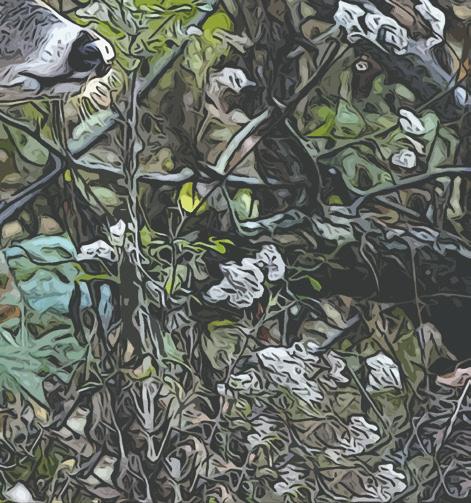
Snowshoe hare (or varying hare) season in the Southern Tier runs from Jan. 1-31.
Canada goose season in southwestern New York reopens Oct. 28 and runs through Nov. 17. A late season opens Nov. 25 and runs through Jan. 21.
Snow geese may be taken at any time through April 15.
General duck season in Western New York runs from Oct. 21-Nov. 12 and then Nov. 25-Dec. 31. Consult the DEC’s regulations for more specific information.
The season dates for fall turkey are Oct. 21-Nov. 3
in the Southern Zone. The statewide fall season bag limit is one bird of either sex. Hunting hours are sunrise to sunset.
The regular firearms season for big game starts Nov. 18 and runs through Dec. 10. Daily hunting hours for deer and bear are 30 minutes before sunrise until 30 minutes after sunset.
On Dec. 11, the muzzleloading and late archery seasons for deer and bear get underway, with crossbows legal throughout.
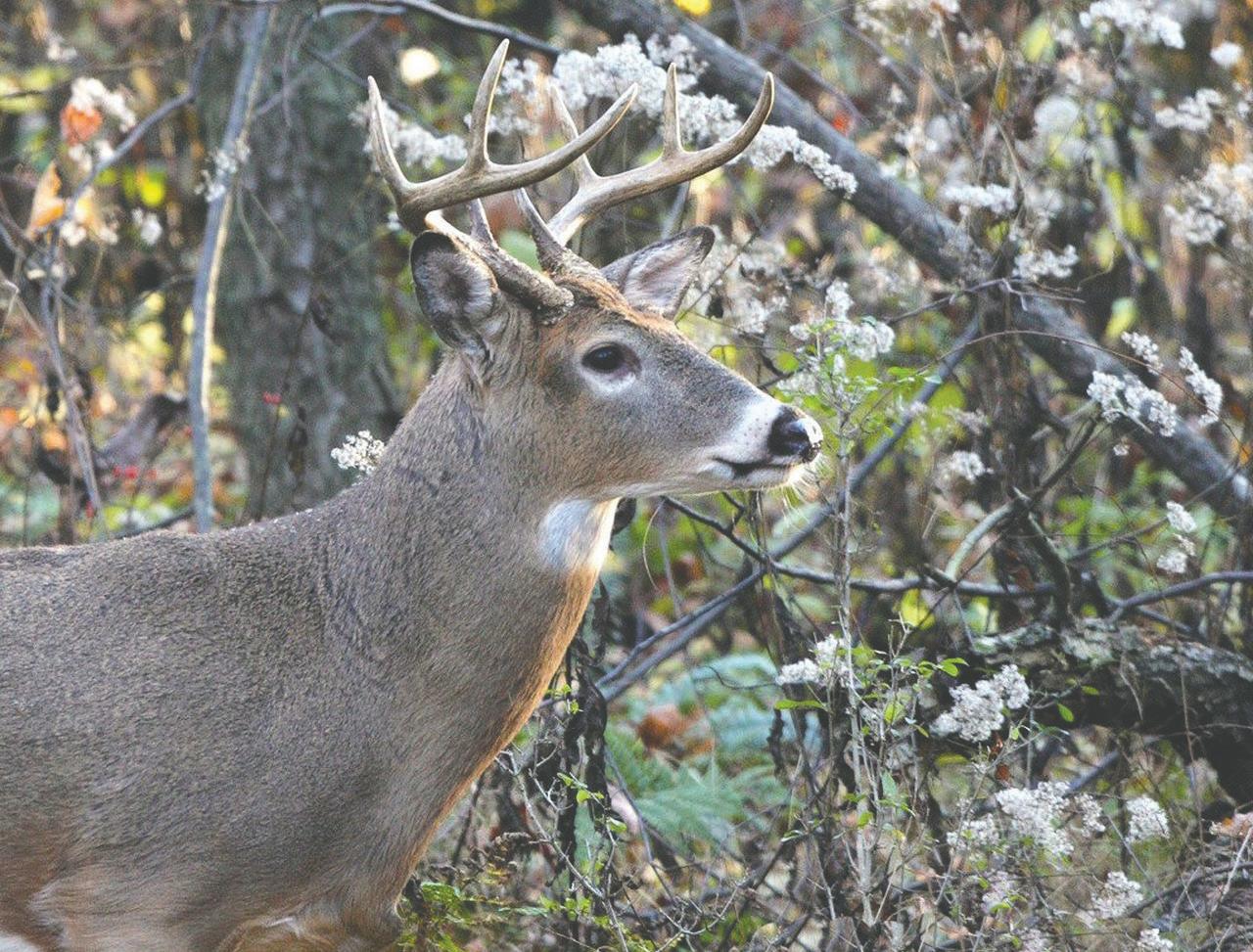
These seasons end Dec. 19. Extra hunting days for deer with a muzzleloader or archery equipment are in place from Dec. 28-Jan. 1.
DEC also reminds hunters of the importance of reporting their harvest. Harvest reporting is critical to wildlife management, and hunters are required to report their harvest of deer, bear, and turkey within seven days of taking the animal.
The easiest way to report is via DEC’s HuntFishNY mobile app. Through this mobile app, hunters, anglers, and trappers can access an electronic version of their licenses and privileges, and report the harvest of deer, bear, and turkey immediately while afield on their mobile device. It takes only seconds.
Hunters may still use the phone report system, but the online and mobile systems are fast, convenient, and easy for hunters to accurately enter information.
Coyotes may be hunted statewide from Oct. 1 through March 31 and there is no limit.
Red and grey fox, raccoons, skunks and weasels may be hunted Oct. 25 through Feb. 15.
Hunting bobcat is permitted in the Southern Tier from Oct. 25 through Nov. 17. Consult DEC regulations regarding reporting a kill.
For trapping seasons and regulations, again, consult DEC regs.

Squirrel hunting season has been underway since Sept. 9, while the more broad small game season that includes cottontail rabbits and grouse starts Oct. 14 and runs through Nov. 24, the day before the opening of the firearms deer season.
During small game season there are two Sundays open to hunting — Nov. 12 and 19.
Pheasant season — any birds found in the Northern Tier are stocked — is Oct. 21-Nov. 11-24, Dec. 11-23 and Dec. 26-Feb. 29. Junior hunters have Oct. 8-15 to hunt pheasants.
Ruffed grouse season picks up again Dec. 11-23 and rabbit season picks up again Dec. 11-23 and Dec. 26Feb. 29. Later squirrel hunting is Dec. 11-23 and Dec. 26-Feb. 29.
In addition to the early season, which starts Sept. 1, Canada geese may be hunted Oct. 28-Nov. 24, Dec. 11-Jan. 20 and Feb. 2-Feb. 24.
General duck season is Oct. 7-21 and Nov. 14-Jan. 6.
Consult the Pennsylvania Game Commission’s regulations for more
specific information about seasons and bag limits for specific species.
In the region that includes McKean, Elk, Cameron and Potter counties, turkeys may be hunted Oct. 28-Nov. 11. Only shotguns or archery equipment may be used to hunt turkey of either sex — no rifles.
There is a muzzleloader season for black bear Oct. 14-21 (only one bear may be taken per license year). Meanwhile, archers may take a bear Oct. 14-Nov. 4.

Oct. 19-21, a special firearms season is set for junior and senior license holders, active duty military and disabled persons' permit holders.
The regular firearms season for bear is Nov. 18-21 while an extended firearms season includes Wildlife Management Unit 3A from Nov. 25-Dec. 2, the first week off the deer firearms season. WMU 3A includes
McKean County east of U.S. Route 219 and north of U.S. Route 6 over to the east beyond Tioga County.
Pennsylvania has several opportunities to hunt deer, with the current archery season running through Nov. 17 and then Dec. 26-Jan. 15.
An early muzzleloader season for antlerless deer is Oct. 14-21 and a special firearms season for antlerless deer for junior and senior hunters, mentored youth, active-duty military and certain disabled permit holders runs Oct. 19-21.
The regular firearm season for both bucks and antlerless deer is Nov. 25-Dec. 9. The flintlock muzzleloader deer season is Dec. 26-Jan. 15.
While only permit holders who received their tags this past August may hunt elk, the season for archery in Pennsylvania was Sept. 16-30, while the general firearms season is Oct. 30-Nov. 4 and late season Dec. 30-Jan. 6.
Coyotes may be hunted and trapped year-round in Pennsylvania and there is no limit. Hunters/trappers may also take a single bobcat during the specific seasons.
Protecting Pennsylvania’s deer and elk from chronic wasting disease remains a top priority for the Pennsylvania Game Commission.
But the rules for hunters who harvest those or any other cervids outside of Pennsylvania or within parts of the state have.
Previously, hunters were prohibited from bringing “high-risk” carcass parts from such animals taken in other states back to Pennsylvania. Hunters were likewise prohibited from moving those parts from any of the state’s Disease Management Areas (DMAs) or the Established Area (EA) to anywhere else in Pennsylvania.
CWD in wild deer has not yet been detected in Pennsylvania’s northernmost counties.
In New York, where there have been no documented cases of CWD in wild deer, it remains prohibited to transport a full deer carcass or highrisk carcass parts into the state from Pennsylvania or other states.
High-risk parts include the head (including brain, tonsils, eyes, and any lymph nodes); spinal cord/backbone; spleen; skull plate with attached antlers, if visible brain or spinal cord tissue is present; cape, if visible brain or spinal cord tissue is present; upper canine teeth, if root structure or other soft tissue is present; any object or article containing visible brain or spinal cord tissue; unfinished taxidermy mounts; and brain-tanned hides.
Those protections were meant to limit the human-assisted spread of CWD, a contagious, always-fatal brain disease affecting members of the deer family, first detected in Pennsylvania in 2012.


Now, to continue battling CWD’s spread while also making things easier on hunters, the Game Commission is allowing hunters who harvest a deer, elk or other cervid outside of Pennsylvania to take it directly to any Game Commission-approved processor or taxidermist anywhere in the state. Hunters who take a deer within any of Pennsylvania’s DMAs or its EA can do the same.
The list of cooperators is available at www.pgc.pa.gov/cwd.
Hunters who process their own deer have options, too. If a hunter harvests a deer within a DMA or the EA and is transporting it home to process within that same DMA or the EA, they can do so as long as the high-risk parts are disposed of through a trash service.
Hunters who live outside a DMA or the EA can quarter the animal to take it home, free of high-risk parts. Also, although not recommended, high-risk parts can remain at the harvest location. But once they’re moved from the harvest location, high-risk parts cannot be placed back onto the landscape.
Game Commission CWD Section Supervisor Andrea Korman said the new rules ensure the proper disposal of high-risk parts, which is one way of
Check the PGC’s regulations for trapping and hunting seasons for furbearers and all other species. CONTINUED ON PAGE 18
But they posed challenges, too. A hunter who harvested a deer within a DMA or the EA but lived elsewhere, for example, likely had to make a return trip to pick up their meat or mount.


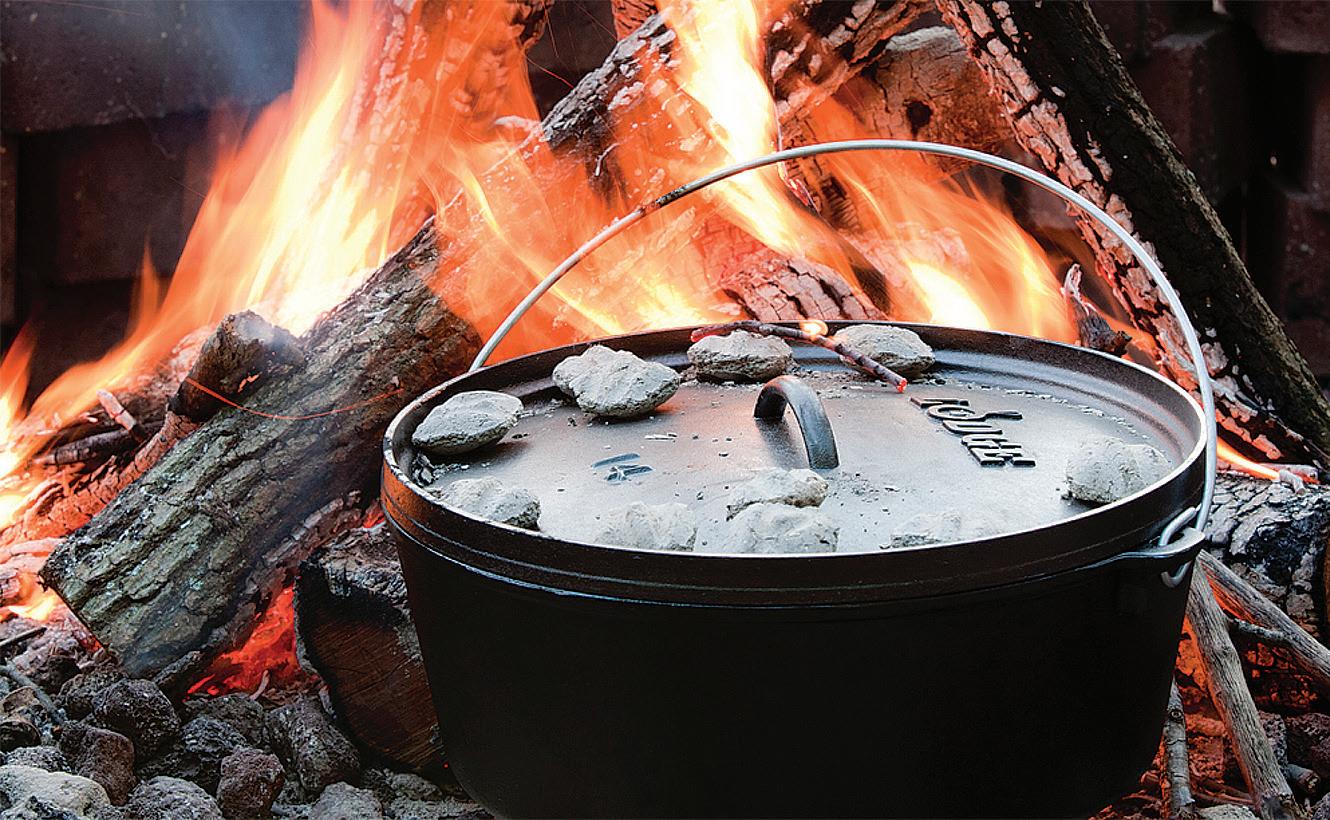





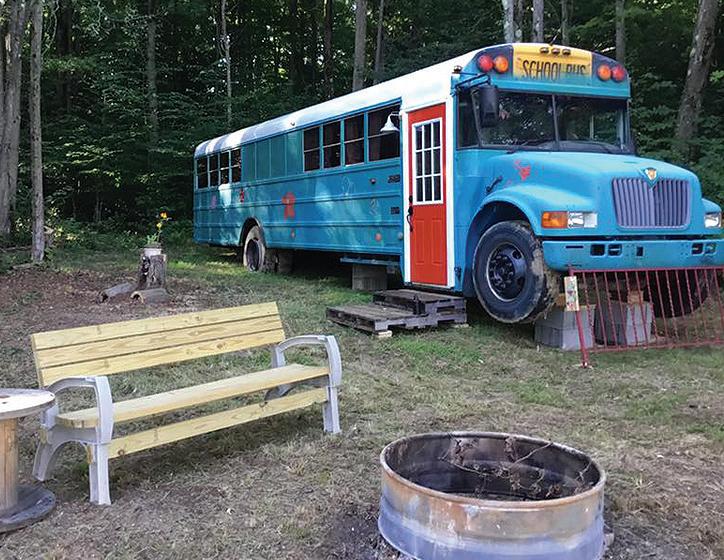





World class fishing, hunting, hiking, sight seeing, and year round outdoor activities are available!
CONTINUED FROM PAGE 16
preventing CWD’s spread to new areas. Processors and taxidermists on the list fill out an annual application, dispose of high-risk parts through a commercial refuse pickup service or other means approved by the agency and provide proof of that disposal method upon request.
Second, they enhance CWD surveillance, as cooperators must allow Game Commission staff to do biological sampling, such as CWD sample collection and deer aging.
Third, they make taking deer more convenient. That’s especially important for in-state hunters pursuing deer within a DMA
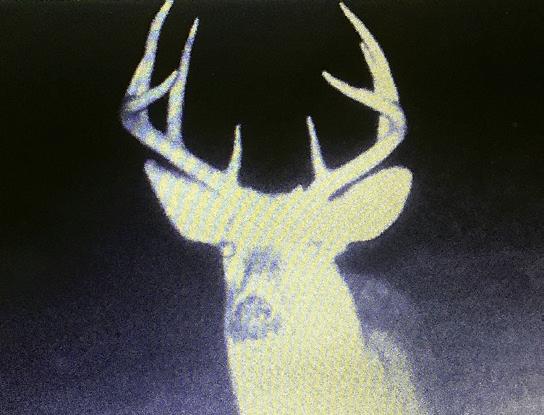
or the EA, since reducing deer densities is one of the only effective methods for limiting CWD’s spread.
“Hunters, who have been our best partners in conservation for over a century, can help reach that goal by hunting and harvesting deer in areas with CWD,” Korman said. “These new rules just make it easier to do that.”
The Game Commission is once again placing head collection bins at multiple locations around the state. They’re identified on the agency’s website. Hunters who drop a deer head in a bin can check test results on the CWD dashboard.
Pennsylvania first
detected CWD in 2012 at a captive deer facility in Adams County. The Game Commission has tested more than 131,000 wild, free-ranging whitetails for CWD since 1998, along with more than 1,900 elk.
To date, CWD has been found in more than 1,400 deer, 243 of those taken by hunters last season. It has not been detected in Pennsylvania’s elk herd.
“Much is still unknown about CWD, so limiting exposure of all species to this known pathogen is essential,” Korman said. “The movement of highrisk carcass parts is a potential avenue through which CWD could be
spread, and one that can be prevented.”
Hunters are prohibited from returning to New York state with whole carcasses or intact heads of deer, elk, moose or caribou taken out of state.
Only the deboned meat, cleaned skull cap, antlers with no flesh adhering, raw or processed cape or hide, cleaned teeth or lower jaw and finished taxidermy products of CWD- susceptible animals may be brought into New York.














kip Adams, chief conservation officer of the National Deer Association, will be the featured speaker at the annual Kinzua Quality Deer Cooperative (KQDC) Season Kickoff program Oct. 22.
Free and open to the public, the KQDC Deer Season Kickoff will be held in the Mukaiyama University Room, Frame-Westerberg Commons at the University of Pittsburgh at Bradford. Doors open at noon and the program will run until 4 p.m.
Adams is well-known to deer hunters across the northeast because of his previous involvement with the Quality Deer Management Association.

“State of the Whitetail – Trends in Harvest and Management Programs” will feature interesting tidbits of information comparing deer, harvest and populations across the northeast, as well as how deer harvests are calculat-








A light lunch will be offered.


Two other speakers for the afternoon will be Dr. Linda Ordiway, “Use of the Online Hunter Map of the Allegheny National Forest (NF),” and KQDC CoordinatorJohn Dzemyan, “How to Improve Your



information to follow.





The KQDC is an ongoing demonstration, begun in 2000, of how hunting can be used to meet multiple goals for managing deer. A partnership of forest landowners, forest managers, biologists, hunters and local businesses developed the program,
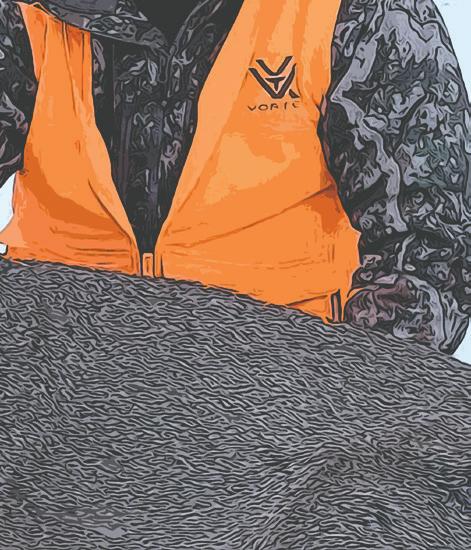
which relies on hunters to manage deer density on a representative forested area.
The KQDC is almost 75,000 acres of public and private lands managed to improve deer populations and habitat. The land is west of Bradford and north of Kane in McKean County. The cooperators are Sand County Foundation, Allegheny National Forest Visitors Bureau, Allegheny National Forest, Bradford Water Authority, Conservation Forestry, Collins Pine Co. (Kane Hardwood) and RAM Forest Products.
Additional information is available at www.kqdc. com or www.Facebook. com/The KQDC.
when the nights begin to cool down in late September and the days grow slowly shorter the fish wake up and take notice.
Now is a great time to be on the water for all species of fish and it’s maddening that hunting and fishing seem to interfere with each other this time of year. How can you hunt archery, squirrels or grouse knowing the cold waters are teeming with fish ready to bite? Unfortunately, you simply can’t be two places at the same time.
If you’re looking for size, Lake Ontario has the mighty chinooks moving in off the mouths of the major tributaries. A 30-pound chinook feels like a horse on steroids ripping around and stripping the line off your reel. They’re a blast to battle and provide a real workout.
Experienced fishermen who frequent the piers and river mouths told me to tie my line onto the reel with a slip knot, a rubber band or not at all if a super-charged, huge chinook tears all the line off your reel. The tremendous force generated when a highspeed salmon hits the end of your line can break the rod, damage the reel, jerk the outfit from your hand or actually sprain wrists and fingers.
As the chinooks run up the rivers the steelhead follow as well as large brown trout to feed on chinook
eggs. The Great Lakes are a fantastic fishery and we’re fortunate to live within easy driving of Lake Erie and Lake Ontario.
Steelhead provide great sport for thousands of anglers in the fall. Fast-paced fishing can be experienced this time of year. During low water conditions thousands of steelhead build up off the mouths of the creeks waiting for the streams to rise. When a hard rain does hit and the waters rise the steelhead come upstream in a solid tide. It’s possible to stand in one spot when this occurs and actually feel the fish bumping into your waders as they swim by.
Walleyes run in the fall as well and some great fish can be caught from shore off creek mouths. They can be a little spooky when close to shore — early and
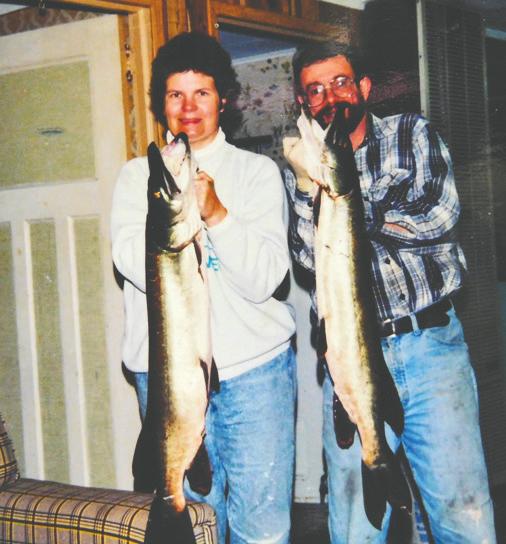
late in the day are the best times to fish for them. The less commotion the better. Minnow baits seem to be very productive this time of year. I like to have some silver on mine.
Lake Chautauqua is close by and the fall weather can provide some excellent fishing here for walleyes, smallmouth bass, largemouth bass and, of course, muskellunge. But if you’re into less stressful fishing the perch school up this time of year and move inshore. I must admit that a fresh fried perch fillet really grabs my attention.
Perch are not really finicky as a rule and minnows, worms or waxworms all produce in abundance once you locate the perch. I’ve had great success using trout jigs on perch, sometimes they outproduce live or natural bait, surprising as that may be to you. But don’t neglect your good old nightcrawlers — they work as well as anything in most circumstances and are cheap and easy to transport, just keep them cold. Perch are also fairly easy to fillet and, as I mentioned, excellent eating.
In the fall and when the moon is full or preferably dark, my heart always thrills to the muskellunge. These unpredictable and savage fish hold a special place in my heart and trigger countless memories, some of which non-fishermen may find hard to believe. Muskies, besides being difficult to catch, are totally unpredictable and
are liable to do the strangest things.
Early one fall morning my wife, Jane, and I were fishing a weed edge. A light breeze drifted us up to a 6-foot floating patch of weeds. Jane retrieved her No. 5 Mepps Muskie Killer within inches of them and just as she was about to lift the lure from the water a green-barred streak grabbed it in a flurry of white water. It was as savage a hit as I’ve ever seen, with spray flying explosively everywhere.
If we thought the water flying from the strike was something, it was nothing compared to the thrashing that took place when the big 'lunge felt the hook. The surface simply erupted, buckets of water flying everywhere. Both our faces, hats, jackets, pants, faces and glasses were drenched. Next, the muskie leaped high out of the water and we found ourselves eyeball to eyeball.
The fish's momentum was carrying it forward enough so it should have fallen in the boat. For a moment, the muskie and I stared at each other, then the fish casually flexed its tail against the gunnel, rotated and fell back into the lake shaking its head — and sending Jane’s Mepps flying through the air.
I sat there dripping and open-mouthed, and then turned and looked at Jane. She was drenched as well, with a shocked expression on her face. We simply
October's full moon — the Hunter’s Moon — will reach peak illumination at 4:24 p.m. on Saturday, Oct. 28.
From a hunting perspective, man has sought to understand how the moon might affect animal behavior for millennia. In some respects, the instincts and anecdotal knowledge accrued by hunters remains a tool in these modern times — while other hunters dismiss any discernible effect.
It should be noted that deer biologists acknowledge a link between the full moon and estrus cycles of whitetail deer, and game departments have amassed statistical data relating deer harvests to moon phases.
Research and personal evidence from seasoned hunters suggest that deer are more active during specific moon phases, particularly around the full moon — but much of that could simply be attributed to the levels of light associated with the phases. In any case, familiarity with the lunar cycle and its impact on deer behavior
can give hunters an advantage in predicting the most advantageous times to be out in the woods. Applying moon phase information to the hunt strategy could ultimately lead to a more enjoyable and successful experience in the field.
Many hunters assert deer patterns are most predictable during the new moon — when the moon is in its dark phase. The figuring goes that deer are less active during dark nights, and therefore more active the following day. Experts cite hunter surveys in different parts of North America — from the South to the North — that have shown up to four times as many deer are seen in daylight hours during the new moon than during any other phase.
Because a first-quarter moon — when the right half is illuminated —rises early in the evening, deer may move little before dark. Dawn hunting can be excellent, however, as deer will have endured several
CONTINUED FROM PAGE 21
stared at each other in disbelief and suddenly began laughing. What a comical sight!
Grabbing the hand towel and we both dried off. What just happened? A free shower from the
king of freshwater gamefish and a memory so incredible it didn’t seem real even to ourselves. How often we relived that unbelievable moment.
Fall fishing ... what memories await you?
hours of total darkness during the wee hours, after the moon has set, and will be eager to move to find feed.
Many hunters and deer experts believe this is the time to on a stand before dawn.
There are different schools of thought regarding the full moon and deer hunting. Many hunters believe that, if the weather is clear overnight during the full moon, deer tend to move and feed overnight since they can see better and yet still feel more secure on the move than during daylight hours.
If that theory — and the clear weather — holds, hunters may find it more challenging to locate deer during the day in these conditions, although hunters should be prepared for sudden shifts in deer movement patterns.
Some experts believe midday movement may increase during the full moon. In one Texas study, several notoriously nocturnal trophy bucks were seen during daylight hours only during periods of the full moon, and then only at midday. Many biologists hold that in northern and central states the first does come into estrus during the second full moon after the autumnal equinox, kicking off the rut.

The suggestion for many whitetail hunting experts is stay on stand in the middle of the day.
During a third-quarter moon (when the left half is illuminated) that shines late in the night, deer feed heavily before dawn and may bed down before daylight. Many hunters report their best success on evening hunts, preceding several hours of total darkness before the moon rises.
And when the onset of the rut coincides with the full moon, the peak period of the rut will occur one week later, during the moon’s third quarter. Therefore, the first third-quarter moon after the Hunter’s Moon can provide the best hunting of the year.
Again, weather conditions as well as pressure from other hunters — or the lack of it — can make a difference with any number of “hunt the moon” theories. But it’s clear that awareness of the moon cycles during the hunting season can be a factor in decision-making — and could lead to more success.




























































